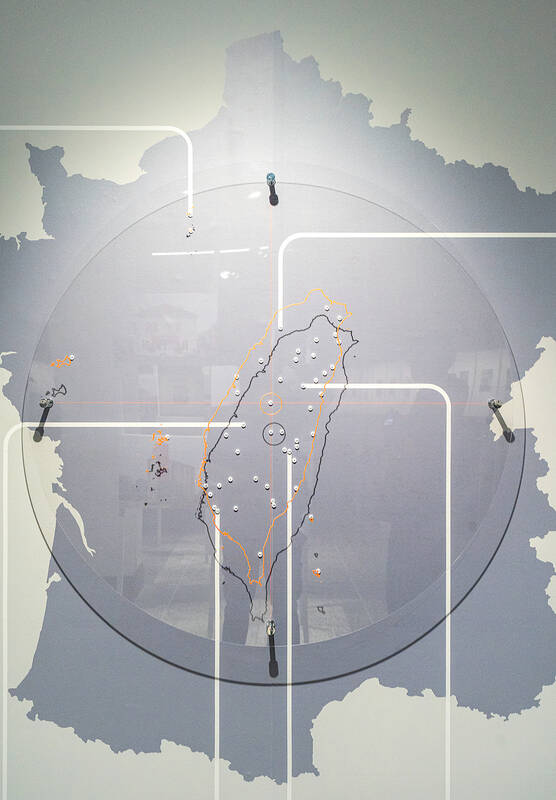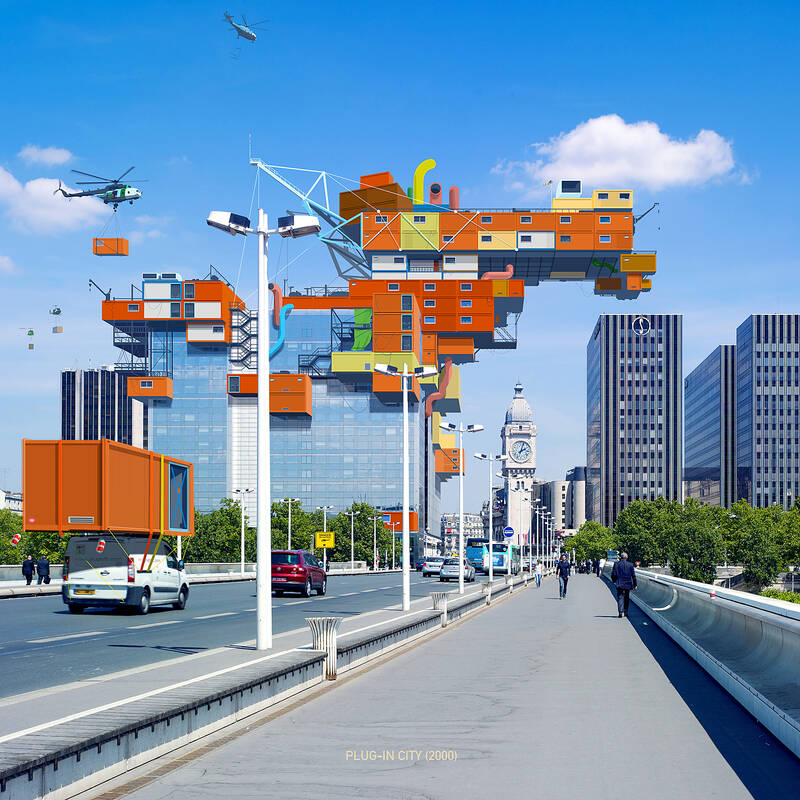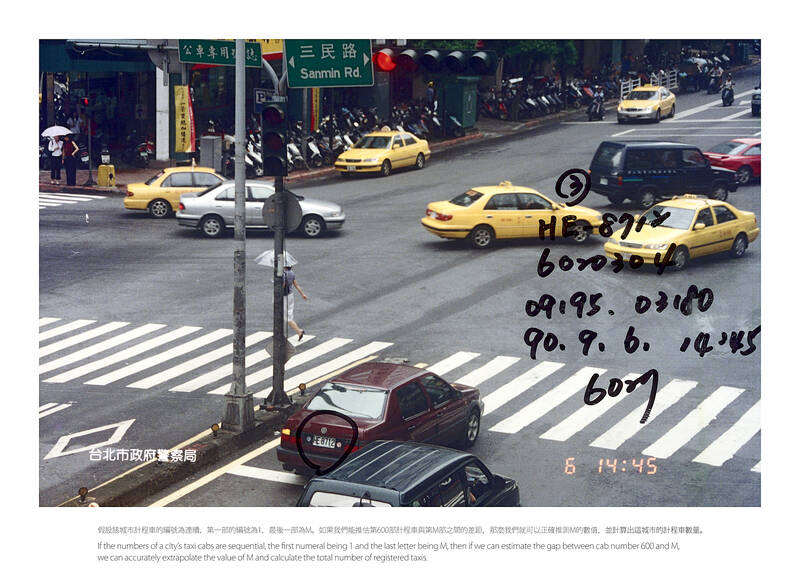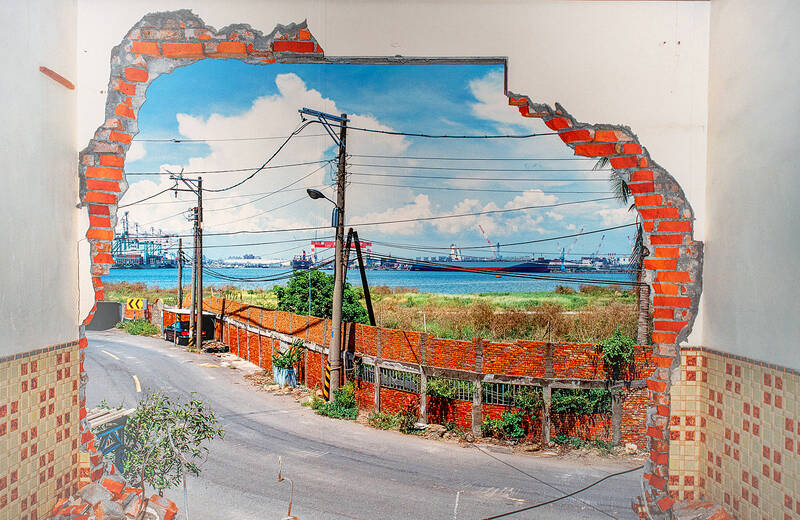Alexia Fiasco’s work is centered on destruction — or rebuilding — depending on your perspective.
Bricks from Taiwan’s military villages sit next to debris from the suburbs of Paris, silently corroborating each other’s stories about displacement, loss and community. A series of worn daily items, taken from the remains of a demolished social housing unit in France, with a self-portrait of a former resident and meaningful items overlaid on top. The subjects look back at the viewer, some smiling, most with mute stares.
“My subjects took the photos themselves; they needed to control their own images,” the artist says, gesturing at the art work behind her.

Photo: Lery Hiciano, Taipei Times
On an adjacent wall, far from the mailboxes of Parisian social housing, is a wall-sized image of what used to be the view from a home, looking out to Kaohsiung’s port. Chen Po-I’s (陳伯義) photograph is not a view from a window, but a wall that has been removed, the rubble of red bricks framing the scene, highlighting the tension between development and the destruction it inevitably brings. The house used to be in the village of Hongmaogang (紅毛港), a once-thriving fishing community that faced decades of issues caused by industrial development and pollution before residents were eventually relocated and the village partially destroyed.
These works are included in Vanites Modernes (“modern vanities), an exhibition at the National Center of Photography and Images. A collaboration between the Ministry of Culture and the Bureau Francais de Taipei, it is split into two parts — Our Territories, which runs from June 24 to Nov. 2, and The City, which opened last Thursday and runs until Nov. 23.
The show features a total of 212 works by 19 artists, 11 French and 8 Taiwanese, and is the result of nearly 10 years of exchanges between the two countries. Curator Hubert Kilian called it “a dream come true.”

Photo: Courtesy of the National Center for Photography and Images
At the exhibition’s opening ceremony, Kilian spoke alongside Minister of Culture Li Yuan (李遠), French Representative to Taiwan Franck Paris and author Raphaele Bertho, introducing its central concept and revealing some of the work necessary to bring it to fruition.
Li spoke on the modern era facing the consequences of “overdevelopment,” such as pollution, climate change and the lack of stability leading to more loneliness and suffering.
However, the opportunity for France and Taiwan to have a mutual understanding in this era of emptiness “is the most beautiful thing,” he added.

Photo Courtesy of the National Center for Photography and Images
Kilian told the audience to take their time with the gallery, “to consider whether the world can still convey hope.”
The central tension in the gallery between the modern city as the pinnacle of human progress and the destruction its reality necessitates, is conveyed through a variety of mediums.
From the repurposed physical objects by Fiasco and Edith Roux to images of Paris mixed with Delhi, to an augmented reality project imagining an alternative present based on futuristic proposals from the 1960s.

Photo Courtesy of the National Center for Photography and Images
The center’s third floor features Our Territories, photographs that deconstruct how humans believe “themselves masters of the Earth,” replacing the natural landscape with “concrete, asphalt and neon.”
It’s a suitable prequel to The City, identifying the conditions essential to the rise of urban living — a human willingness to transform nature, exploit it and separate ourselves from it through conceptions of civilization and culture.
One of the more sublime works is Tattoo on the Earth, a series by Chang Chih-ta (張志達), where he focuses on street lines. The bird’s eye view detaches the observer from the ground, the black concrete obscures whatever natural landscape once existed and the lines are revealed to be an arbitrary imposition.

Photo: Lery Hiciano, Taipei Times
Overall, the exhibition is an interesting walk through nearly two dozen viewpoints on humanity and modernity, highlighting the shared experience across global boundaries, juxtaposing European landscapes across the room from Taiwanese temples in service of demonstrating core features of the modern human experience.
“I hope the ideas generated through this dialogue between French and Taiwanese artists can be brought back to France and all over the world,” Paris said.

Photo Courtesy of the National Center for Photography and Images

Photo: Lery Hiciano, Taipei Times

As I finally slid into the warm embrace of the hot, clifftop pool, it was a serene moment of reflection. The sound of the river reflected off the cave walls, the white of our camping lights reflected off the dark, shimmering surface of the water, and I reflected on how fortunate I was to be here. After all, the beautiful walk through narrow canyons that had brought us here had been inaccessible for five years — and will be again soon. The day had started at the Huisun Forest Area (惠蓀林場), at the end of Nantou County Route 80, north and east

Specialty sandwiches loaded with the contents of an entire charcuterie board, overflowing with sauces, creams and all manner of creative add-ons, is perhaps one of the biggest global food trends of this year. From London to New York, lines form down the block for mortadella, burrata, pistachio and more stuffed between slices of fresh sourdough, rye or focaccia. To try the trend in Taipei, Munchies Mafia is for sure the spot — could this be the best sandwich in town? Carlos from Spain and Sergio from Mexico opened this spot just seven months ago. The two met working in the

Exceptions to the rule are sometimes revealing. For a brief few years, there was an emerging ideological split between the Democratic Progressive Party (DPP) and Chinese Nationalist Party (KMT) that appeared to be pushing the DPP in a direction that would be considered more liberal, and the KMT more conservative. In the previous column, “The KMT-DPP’s bureaucrat-led developmental state” (Dec. 11, page 12), we examined how Taiwan’s democratic system developed, and how both the two main parties largely accepted a similar consensus on how Taiwan should be run domestically and did not split along the left-right lines more familiar in

A six-episode, behind-the-scenes Disney+ docuseries about Taylor Swift’s Eras Tour and Rian Johnson’s third Knives Out movie, Wake Up Dead Man, are some of the new television, films, music and games headed to a device near you. Also among the streaming offerings worth your time this week: Chip and Joanna Gaines take on a big job revamping a small home in the mountains of Colorado, video gamers can skateboard through hell in Sam Eng’s Skate Story and Rob Reiner gets the band back together for Spinal Tap II: The End Continues. MOVIES ■ Rian Johnson’s third Knives Out movie, Wake Up Dead Man